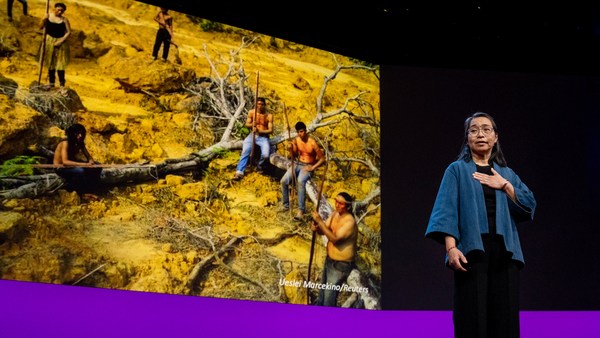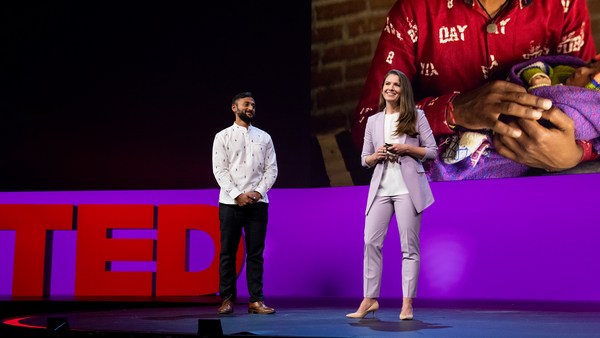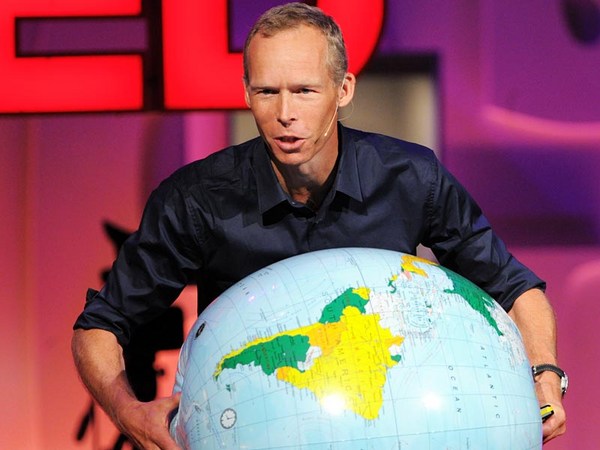So whenever I tell people I’m an Arctic scientist, the first thing that they always ask me is: How cold is it up there?
(Laughter)
And yeah, the Arctic can get pretty cold. Trust me when I tell you that working outside at -40 degrees is really, really challenging. But in the summer of 2019, it was anything but cold.
So that summer I was working with my research team in Alaska’s Yukon Kuskokwim Delta on the traditional lands of the Yup’ik and Cup’ik people. And we were up there hauling hundreds of pounds of equipment across the tundra in the middle of a record-breaking heatwave. It was 90 degrees Fahrenheit. There was no breeze, nowhere to go for a shade and seemingly endless miles of tundra as far as my eyes could see. To make matters worse, the land had drastically changed since we had been here just one year before. The ground was sinking and it was cracking. In places, it was literally collapsing beneath my feet. I’ve been working in the Arctic for more than a decade, and I had never seen changes happening this rapidly ever before. The changes we saw were remarkable, and they were also really concerning. But we were there to measure changes that we couldn’t see. We were there to fill a major gap in our understanding of how the changing Arctic is impacting the Earth’s climate.
So we were installing what’s called an “eddy covariance tower,” which is a series of instruments that measures the exchange of greenhouse gases, like carbon dioxide and methane, between the land and the atmosphere. It’s essentially like measuring the Earth’s breath. And so the reason the land around us was collapsing is because the once permanently frozen ground called permafrost was starting to thaw. And once it thaws, that collapsing ground can drastically alter the vast expanse of the Arctic’s tundra and boreal forest, and it can also threaten the homes and lifeways of Arctic residents. Just imagine if the ground beneath your home suddenly started to sink. That's what's happening across the Arctic.
But thawing permafrost also threatens everyone on the planet because it stores a massive amount of ancient frozen carbon. And when that carbon thaws, it can be released into the atmosphere as greenhouse gases, leading to more warming and more thaw. So let me place the magnitude of this problem in perspective for you. By the end of this century, greenhouse gas emissions from thawing permafrost may be on par with some of the world’s leading greenhouse-gas-emitting nations, perhaps as large as or larger than emissions from the United States, the second-largest greenhouse-gas-emitting country in the world.
And you know, I want to point out, this is not a new phenomena. Arctic residents and scientists have been observing permafrost thaw now for decades. But the scale of the research hasn’t been sufficient to meet this enormous challenge. Because no one country is directly responsible for permafrost thaw, no single nation has taken responsibility for fully monitoring and tracking its impact across the Arctic. And this is not a case where ignorance is bliss, because what doesn't get measured doesn't get accounted for. Because we can’t put a precise number on permafrost emissions, policymakers are essentially excluding them, setting global emissions targets that are wholly insufficient to protect us from catastrophic climate change. Ignoring permafrost is essentially like leaving a major greenhouse-gas-emitting country, like the United States, out of global climate negotiations, which is not a good idea. What we need to know is where permafrost is thawing across the Arctic and how fast, what that means in terms of greenhouse gas emissions and how that will impact our climate in 10, 50 or 100 years from now. Answering these questions requires a massive and integrated effort at a scale that matches the enormity of this problem. Thankfully, we have a plan.
Through an ambitious new initiative called Permafrost Pathways, we’ve formed a coalition of Arctic residents and scientists, Indigenous knowledge-holders and Arctic and climate policy influencers to tackle this problem with the urgency it deserves. Recognizing that we cannot continue on our current climate trajectory, we’ve brought this team together to think big and to act boldly and to work across boundaries to take us on a new pathway forward.
So to get started, the first thing that we need to do is to actually measure greenhouse gas emissions across the entire Arctic. Currently there are only a handful of monitoring towers across the Arctic that run year round and that measure both important greenhouse gases, carbon dioxide and methane. So we’re working with a team of international scientific experts to strategically identify and fill these monitoring gaps by installing new equipment across the Arctic in remote locations where monitoring currently doesn’t exist. We believe that by installing just 10 new monitoring sites, we can drastically improve our estimates of permafrost emissions, which will remove a major barrier to their incorporation into the global climate policy. And we’re coupling this on-the-ground monitoring with high-resolution satellite observations and advanced computer modeling so that we can track the changing Arctic in near real-time and accurately project permafrost emissions into the future.
But state-of-the-art science just isn’t enough. We need to make sure that permafrost emissions are counted when setting global emissions targets, because each year that we fail to account for permafrost is another year that we become unwittingly locked-in to more severe climate warming. So we’re working with leading policy experts to bring this new knowledge to the table with the decision-makers at the highest level to make sure that global climate policy is accounting for permafrost and aiming for the right targets.
But the truth is, even with the most ambitious climate action, some permafrost is going to thaw -- that’s already happening. Right now across the Arctic, people are having to make extremely difficult decisions about where and how to live in order to protect themselves and their families from the hazards of climate change. So we’re working with our team members and our partners who live on permafrost to bring these monitoring and modeling tools to assess the current and future impacts of permafrost thaw on Arctic communities, and to co-create adaptation plans that protect and respect the health, well-being and human rights of Arctic residents.
These are the gaps we plan to fill. Painting a picture of the Arctic that we have never been able to see before, and recognizing that ultimately, the climate crisis is a human rights crisis, and it’s one that’s already underway. But through these actions that we take now, we can greatly reduce future harm and take us on a more just and equitable journey.
Thank you.
(Applause and cheers)





